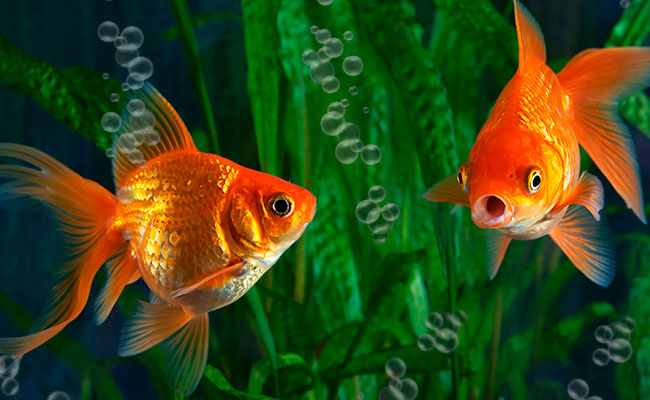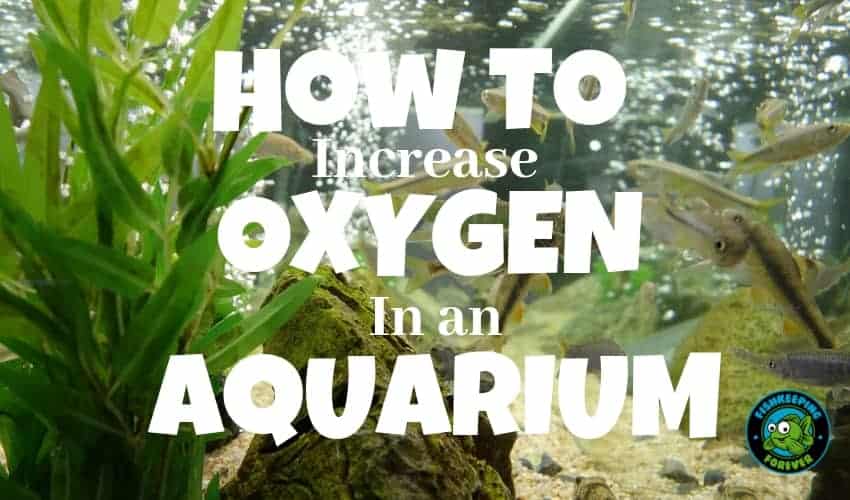
Dissolved oxygen will increase as pressure increases. Although some species such as bettas and gouramis are capable of breathing air sufficient oxygen levels should always be maintained in the water for all fish.

The newly agitated water will introduce more oxygen to the aquarium while the increased water movement will improve the oxygen exchange buying some time to address the underlying cause.
Increasing dissolved oxygen in aquarium. In case of emergency you can instantly increase the oxygen level in your aquarium by simply pouring down some aquarium water using a jar from some height. You can also do a large water change of up to 50 of water to increase oxygen in the fish tank. If youre in a critical situation youre not looking for a lot of unrelated information.
This is how you increase oxygen levels quickly to solve a problem temporarily. Perform a large water change to increase the oxygen level. If youre in a situation where you must increase oxygen ASAP remove 40 50 of the aquarium water and replace it.
Protein skimmers are also an excellent method for increasing the oxygen levels in marine aquarium water. Salinity is measured in Parts per thousand ppt or Specific Gravity SP and the dissolved oxygen content is measured in parts. The easiest and quickest way to get oxygen into your aquarium is to immediately perform a large water change as much as 50.
The new water will bring with it dissolved oxygen that should keep your fish happy in the short term. This will buy you some time so that you can hunt for the cause of the depleted oxygen. Too much oxygen in an aquarium.
Increasing temperatures and salinity will allow less oxygen to be saturated in the water. For example a freshwater aquarium with a temperature of 75 F can dissolve 84 ppm of oxygen. A saltwater tank with a temperature of 824 F and a salinity of 15 ppt can dissolve 718 of oxygen.
Aeration and dissolved oxygen in the aquarium. A guide that contains just about everything you need to know about this topic. Oxygen is important for fish life too as it is for human.
Dissolved O2 DO is considered such oxygen thats dissolved in water. Fish takes DO directly into their blood with the help of gills. In the average aquarium amounts of dissolved oxygen DO vary during both the day and night never remaining entirely constant.
Brightly illuminated tanks cause micro and macro algae to photosynthesise at a rapid rate causing oxygen to be given off as a by-product. They will also pipe taking in the water at the surface of the aquarium where the water has more oxygen dissolved in it. In a aquarium with a wavemaker andor lots of current the fish will swim in the current with their mouths gaping allowing the current to flow water rapidly over their gills.
The newly agitated water will introduce more oxygen to the aquarium while the increased water movement will improve the oxygen exchange buying some time to address the underlying cause. Next the additional corrective steps will depend on the root cause of the low oxygen level which should be determined promptly to assure the problem is permanently. Dissolved oxygen remained just below saturation during the procedure O2 fell slightly with rising temperature.
Skimmer and large circulation pump removed at 815 am circulation pump replaced with a smaller unit Temperature fell by 144 F over the next 15 hours due to removal of two warm pumps Dissolved oxygen dropped also by 032 ppm. Dissolved oxygen DO refers to the oxygen gas that is dissolved in water. Fish absorb the DO directly from the water into their bloodstream through their gills.
Although some species such as bettas and gouramis are capable of breathing air sufficient oxygen levels should always be maintained in the water for all fish. Dissolved oxygen refers to the Included with this study is the amount of oxygen contained in water. Qualitative determination of oxygen in According to United States tap water after immersing the two Environmental Agency US EPA plants in a beaker for one week setup 2012 aquatic systems obtain oxygen 1 and another pair of plants in a from the atmosphere through.
How to Increase Dissolved Oxygen In Aquarium. Apart from testing your fish tanks dissolved oxygen level there is no easy way to understand a low oxygen situation. Fishkeepers usually anticipate by closely observing the fish behavior.
When the tank oxygen level is low fish will manifest some visible signs. Oxygenation It is the process of adding oxygen to water in order to increase dissolved oxygen. Aeration It increases the gas exchange between the atmosphere and aquarium by providing better contact with air.
Aeration is the process of adding oxygen to water whereas oxygenation is the process of increasing dissolved oxygen. Dissolved oxygen increase with Bio-Organic Catalyst. Plants are one of the major sources for improving dissolved oxygen in natural water bodies.
We can also adapt this by adding live plants and planktons inside the tank. These plants release oxygen inside the water and improve overall dissolved oxygen inside the tank. Dissolved Oxygen is the amount of gaseous oxygen O2 dissolved in the water.
Oxygen enters the water by direct absorption from the atmosphere by rapid movement or as a waste product of plant photosynthesis. Dissolved oxygen levels that drop below 50 mgL cause stress to aquatic life. Causes Of Low Dissolved Oxygen In Fish Tanks Overcrowding.
Stocking your aquarium with more fish than is ideal for it is not a good idea as there will be competition for the dissolved oxygen in the aquarium. It is therefore better to stock the aquarium with fish according to its capacity. In the aquarium surface agitation increases the oxygen content of the water and this is achieved through aquarium equipment that can disturb the water surface.
Essentially ample levels of dissolved oxygen are required for animals to breathe and plants to conduct photosynthesis. Oxygen enters the aquarium through gas exchange in two ways. The amount of oxygen that can be dissolved saturated in the water is dependent on the water temperature and salinity levels.
Increasing temperatures and salinity will allow less oxygen to be saturated in the water. Dissolved oxygen will increase as pressure increases. This is true of both atmospheric and hydrostatic pressures.
Water at lower altitudes can hold more dissolved oxygen than water at higher altitudes. Why is there a relationship between temperature and oxygen. When temperature reaches to a certain value around 150 C the oxygen consumption.